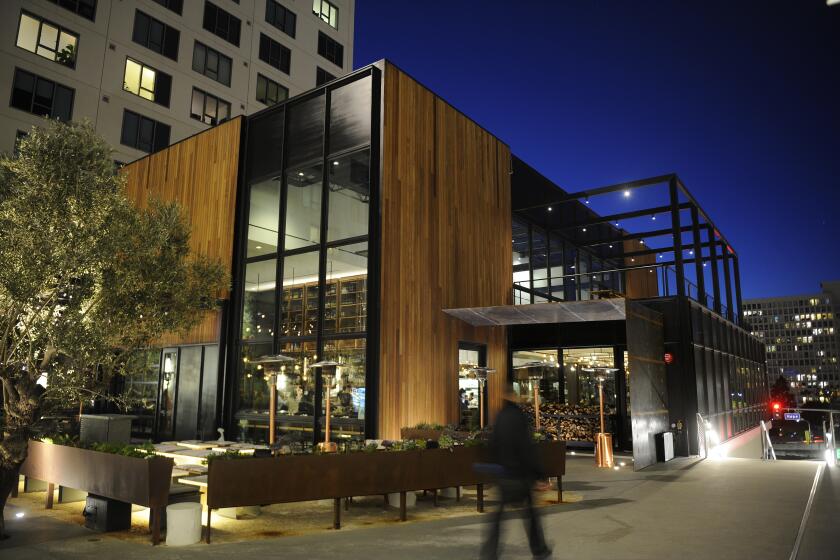KB Thinks Big -- and Small
Since Southern California’s housing bust more than a decade ago, KB Home Corp. has kept a laser-like focus on churning out affordably priced houses for first-time buyers. The strategy has paid off handsomely for the Los Angeles-based company, which on Friday reported another double-digit increase in quarterly profit.
But maintaining stellar growth is likely to come much harder for the nation’s fifth-largest home builder.
The new-home-building industry is bracing for a sales slowdown this year, and a projected rise in mortgage rates would knock a disproportionate number of entry-level buyers out of the market. That could make KB Home more vulnerable than rivals such as Lennar Corp. and Pulte Homes Inc., which sell homes to a wider spectrum of buyers.
“If rates shoot up and you only offer entry-level product, then you are going to hurt more than the other builders,” said James F. Wilson, a housing industry analyst at JMP Securities.
In California -- KB Home’s largest and most profitable market -- a shortage of developable land has compounded the challenges. With the cost of housing lots rising even faster than home prices, KB is finding it tougher to build the relatively low-priced dwellings its customers demand and still generate the profit Wall Street expects.
KB Home says it has a three-year supply of lots in California, but the company is running out of places where it can profitably build entry-level products. Last year, KB’s average selling price in California was $318,300, up more than 12% from 2001. During the first quarter of this year, the average sales price jumped to nearly $349,000.
Bruce Karatz, KB’s chief executive, said the company was responding to the rapid appreciation by dramatically boosting construction of lower-priced condominiums, which eventually could account for 25% of the properties KB builds in California, up from less than 10% last year.
This would be a significant change for KB, which is best known for producing single-family tract houses on the suburban fringe.
By building condos, KB figures, it can pack more homes into the same area than it can with detached houses, thus maintaining its sales volume and appeal to its core customers, including young couples and immigrant families. In Rancho Cucamonga, for example, the company is selling condos starting at slightly more than $200,000 -- nearly $60,000 less than the price of detached dwellings in the same development.
For entry-level buyers, condos eventually are “going to be the only type of housing that will be left,” Karatz said.
At the same time, Karatz also has continued to wean KB from its long dependence on California. In recent years, the company has bought smaller home builders in fast-growing states such as Arizona, Nevada, Texas and Florida.
This week, KB acquired Colony Homes -- the second-largest home builder in Atlanta -- for an undisclosed price in a deal that would allow KB to tap into the nation’s largest new-home market. Last year, privately owned Colony generated revenue of $244 million and built 1,872 homes.
California now accounts for about 23% of KB’s completed units, compared with nearly 70% in the mid-1990s. In fact, last year the company delivered more houses in Texas -- 7,873 -- than it did in California, with 5,344.
“A lot of the things they have done have improved” their business model, said Bob Curran, an analyst who follows the housing industry for credit firm Fitch Ratings.
KB, which last year built more than 25,000 dwellings, has posted double-digit earnings growth for at least five years. On Friday, the company said net income in the quarter ended Feb. 28 rose 24% to $52.8 million, or $1.25 a share, from $42.7 million, or 95 cents, a year earlier. Revenue rose 20% to $1.09 billion. KB Home shares rose 27 cents to close Friday at $45.49 on the New York Stock Exchange.
Karatz said he expected KB’s revenue to grow at double-digit levels this year despite a dip in new-home sales nationwide and a potential rise in mortgage rates. KB Home is counting on growing primarily by expanding its share of a shrinking market by stepping up its pace of new developments. He said KB planned to open 90 communities for sale during the current quarter, about triple last year’s count.
Certainly, KB Home is in far better shape today than it was when Southern California’s real estate market collapsed in the early 1990s, when the company, then known as Kaufman & Broad, built housing primarily on a speculative basis. Now, KB operates a highly efficient production method that churns out units only after they have been sold.
What’s more, KB Home’s focus on entry-level buyers and homeowners who trade up for the first time has made a difference, setting the company apart from most of the other major publicly owned builders.
Although risks of a slowdown in the entry-level market have increased recently, KB’s properties nationwide still sell for less than the average of many other new homes. That has enabled KB to attract a big share of former apartment dwellers as well as minorities and immigrants, who make up about one-third of its buyers nationwide.
“The immigrant population continues to be a strong component of the home-buying group,” Karatz said.
More to Read
Inside the business of entertainment
The Wide Shot brings you news, analysis and insights on everything from streaming wars to production — and what it all means for the future.
You may occasionally receive promotional content from the Los Angeles Times.










